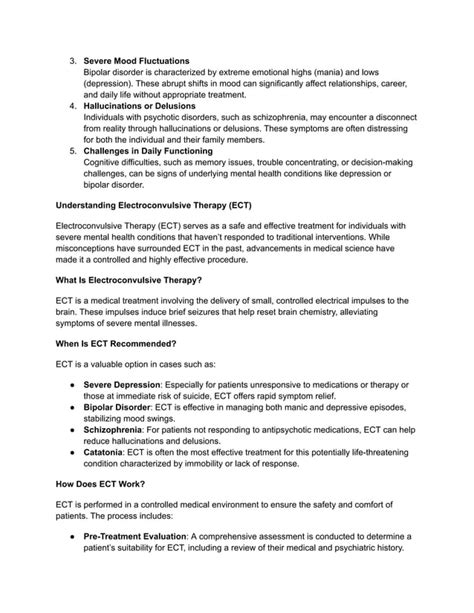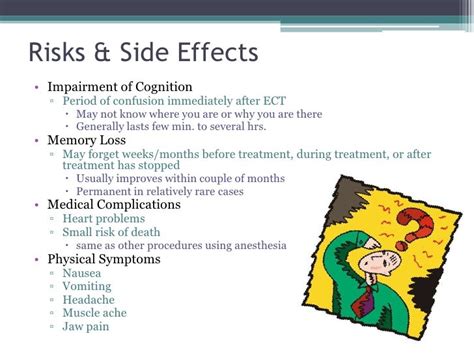Intro
Discover ECT treatment, a psychiatric therapy using electroconvulsive therapy to treat mental health conditions like depression, anxiety, and bipolar disorder, through a safe and controlled procedure.
Electroconvulsive therapy, commonly referred to as ECT, is a medical treatment that has been used for decades to help individuals suffering from severe mental health conditions. The importance of understanding ECT treatment cannot be overstated, as it has been a lifesaver for many people who have not responded to other forms of treatment. Despite its effectiveness, ECT remains shrouded in mystery and misconception, making it essential to delve into the world of ECT and explore its benefits, working mechanisms, and the steps involved in the treatment process.
The significance of ECT treatment lies in its ability to provide relief to individuals who are struggling with treatment-resistant mental health conditions, such as severe depression, bipolar disorder, and schizophrenia. These conditions can have a devastating impact on a person's quality of life, causing significant distress and impairment in daily functioning. ECT has been shown to be a highly effective treatment option for these individuals, offering a beacon of hope when other treatments have failed. As we navigate the complexities of ECT, it is crucial to separate fact from fiction and explore the realities of this treatment option.
The history of ECT is fascinating, with the treatment first being introduced in the 1930s. Over the years, ECT has undergone significant transformations, with advances in technology and technique leading to improved safety and efficacy. Today, ECT is a highly regulated treatment that is only administered by trained medical professionals in a controlled environment. As we explore the world of ECT, it is essential to understand the various aspects of the treatment, including its benefits, risks, and the steps involved in the treatment process.
What is ECT Treatment?

ECT treatment involves the use of electrical impulses to stimulate the brain, with the goal of relieving symptoms of mental health conditions. The treatment is typically administered under general anesthesia, with the patient being closely monitored throughout the procedure. ECT can be used to treat a range of conditions, including severe depression, bipolar disorder, and schizophrenia. The treatment has been shown to be highly effective, with many patients experiencing significant improvement in their symptoms after just a few sessions.
How Does ECT Work?
The exact mechanisms of ECT are not fully understood, but research suggests that the treatment works by stimulating the brain's neural activity. This can lead to changes in brain chemistry, which can help to alleviate symptoms of mental health conditions. ECT has been shown to increase the production of neurotransmitters, such as serotonin and dopamine, which play a crucial role in regulating mood and emotions. The treatment has also been found to have anti-inflammatory effects, which can help to reduce inflammation in the brain and promote healing.Benefits of ECT Treatment

The benefits of ECT treatment are numerous, with the treatment offering a range of advantages over other forms of therapy. Some of the key benefits of ECT include:
- Rapid relief from symptoms: ECT can provide rapid relief from symptoms, with many patients experiencing significant improvement after just a few sessions.
- High efficacy: ECT has been shown to be highly effective, with response rates ranging from 50-90%.
- Low risk of side effects: ECT is generally considered to be a safe treatment, with a low risk of side effects.
- Ability to treat treatment-resistant conditions: ECT can be used to treat conditions that have not responded to other forms of treatment.
Steps Involved in ECT Treatment
The steps involved in ECT treatment are straightforward, with the process typically involving the following stages: 1. Initial consultation: The patient will meet with a trained medical professional to discuss their symptoms and determine whether ECT is a suitable treatment option. 2. Preparation: The patient will be prepared for the treatment, which may involve undergoing a physical examination and providing a medical history. 3. Administration of anesthesia: The patient will be administered general anesthesia to ensure their comfort and safety during the procedure. 4. Administration of ECT: The ECT treatment will be administered, with the patient being closely monitored throughout the procedure. 5. Recovery: The patient will be taken to a recovery room, where they will be monitored until they are fully awake and alert.Risks and Side Effects of ECT Treatment

While ECT is generally considered to be a safe treatment, there are some risks and side effects that patients should be aware of. Some of the potential risks and side effects of ECT include:
- Memory loss: ECT can cause memory loss, particularly in the short-term.
- Confusion: Patients may experience confusion and disorientation after the treatment.
- Headache: ECT can cause headaches, which are usually mild and temporary.
- Muscle ache: Patients may experience muscle ache, particularly in the jaw and face.
Who is a Candidate for ECT Treatment?
ECT treatment is typically reserved for individuals who have not responded to other forms of treatment. Candidates for ECT treatment may include: * Individuals with severe depression who have not responded to medication or therapy. * Individuals with bipolar disorder who are experiencing a severe episode. * Individuals with schizophrenia who are experiencing severe symptoms.Conclusion and Next Steps

In conclusion, ECT treatment is a highly effective and safe treatment option for individuals suffering from severe mental health conditions. While there are some risks and side effects associated with the treatment, these can be managed with proper care and monitoring. If you or a loved one is struggling with a mental health condition, it is essential to consult with a trained medical professional to determine whether ECT is a suitable treatment option. With its ability to provide rapid relief from symptoms and high efficacy, ECT treatment is an option that should not be overlooked.
We invite you to share your thoughts and experiences with ECT treatment in the comments section below. Your input can help to raise awareness and promote understanding of this important treatment option. Additionally, we encourage you to share this article with others who may be struggling with mental health conditions, as it may provide them with the information and hope they need to seek help.
What is ECT treatment used for?
+ECT treatment is used to treat a range of mental health conditions, including severe depression, bipolar disorder, and schizophrenia.
How does ECT work?
+ECT works by stimulating the brain's neural activity, which can lead to changes in brain chemistry and help to alleviate symptoms of mental health conditions.
What are the benefits of ECT treatment?
+The benefits of ECT treatment include rapid relief from symptoms, high efficacy, and a low risk of side effects.
